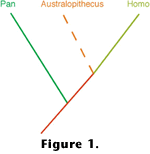INTRODUCTION
As a historical science, paleontology readily presents questions that cannot be answered via empirical methods. For instance, paleobiologists wishing to understand how an extinct animal viewed its surroundings have infrequent access to tissues that mediated visual perception. Soft tissue preservation is a rare occurrence even within the set of rare occurrences in which anything at all is preserved from an animal that lived long ago. Needless to say, even when fragments of fossilized soft tissue are found they are non-functional.
On the other hand, the fossil record has been relatively generous to those pursuing answers to particular questions about perception.
Farlow (1994) addressed questions about tyrannosaur lifestyle with simple geometrical considerations about the position of their eyes relative to the ground. Similarly, an animal's total field of view and area of stereoscopic overlap can be determined from physical measurements of its skull
(Stevens 1997,
Coates 1998). Preservation of the lenses of trilobite eyes provides enough detail to indicate the acuity of their bearers' vision
(Fordyce and Cronin 1989,
Fordyce and Cronin 1993), and a few cranial endocasts provide detail on the relative sizes of different brain regions in skulls that have been particularly well preserved (e.g.,
Stensiö 1927 in
Gould 1988;
Rogers 1998; Brochu, personal commun., 1999; and
Paleoneurology:
the Study of Brain Endocasts of Extinct Vertebrates on the University of
Wisconsin site
Comparative Mammalian Brain
Collections).  Here I follow a different approach. I wish to explore the visual capacities of extinct animals via extant phylogenetic bracketing (EPB,
Witmer, 1995) the method described in
Figure 1. Whereas
Witmer (1995) inferred that Tyrannosaurus rex had eyeballs, I will go further out on the limb and infer what sorts of receptors it had within those eyeballs.
Here I follow a different approach. I wish to explore the visual capacities of extinct animals via extant phylogenetic bracketing (EPB,
Witmer, 1995) the method described in
Figure 1. Whereas
Witmer (1995) inferred that Tyrannosaurus rex had eyeballs, I will go further out on the limb and infer what sorts of receptors it had within those eyeballs.
Gordon
Walls (1942) compiled much of what we know about comparative visual anatomy in vertebrates almost 60 years ago. In many areas Walls' treatise still represents the envelope of our knowledge, but revolutions in some areas of science - particularly molecular biology and electrophysiology - have rendered other parts of his treatise hopelessly inadequate. Relevant to the latter parts, I will here describe some of the newer data and its potential relevance to paleontology. I will also highlight some of the former areas where the relative paucity of newer information suggests we
should be
focusing efforts to fill the holes in our understanding of organisms past and present.

 Here I follow a different approach. I wish to explore the visual capacities of extinct animals via extant phylogenetic bracketing (EPB,
Witmer, 1995) the method described in
Figure 1. Whereas
Witmer (1995) inferred that Tyrannosaurus rex had eyeballs, I will go further out on the limb and infer what sorts of receptors it had within those eyeballs.
Here I follow a different approach. I wish to explore the visual capacities of extinct animals via extant phylogenetic bracketing (EPB,
Witmer, 1995) the method described in
Figure 1. Whereas
Witmer (1995) inferred that Tyrannosaurus rex had eyeballs, I will go further out on the limb and infer what sorts of receptors it had within those eyeballs.